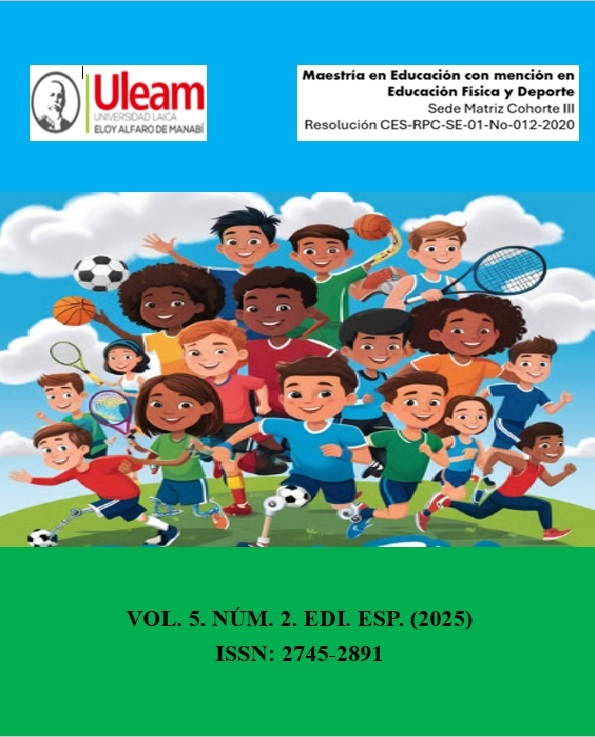Relay games to encourage comprehensive participation in higher basic education students
Abstract
The game is of utmost importance to the teaching process and more in the area of physical education, its transversal implication has allowed students to achieve significant learning in different areas, from demotivation, poor integration in classes it is important to make a theoretical review of different authors on Relay games to encourage comprehensive participation in students of higher basic education in this particular a documentary review of 29 research papers was carried out, among which stand out articles published in journals indexed in catalogs Scopus, Scielo, latindex 2.0, as well as others of free access available in Google scholar, for this the historical logical, analytical synthetic methods were used, on the other hand it is supported by the post positivist paradigm with a qualitative approach of an interpretive, hermeneutic type, within the methodological process the archeology of sources, the review, the comparison, interpretation and conclusions were proposed, within the most important results the pedagogical use of relay games stands out as an effective strategy to encourage the comprehensive participation of students of higher basic education. These games, by simultaneously involving physical, cognitive, and social components, align with the objectives of quality comprehensive education.
Downloads
References
Alotaibi, M. S. (2024). Game-based learning in early childhood education: A systematic review and meta-analysis. Frontiers in Psychology, 15, 1307881. https://doi.org/10.3389/fpsyg.2024.1307881
Andika, W. D., Berliani, R., Sumarni, S., Nusantara, D. S., Cahyani, F. I., & Maharani, S. (2024). ESTABICAH: Relay of Cacah Numbers Games for Mathematics Skills in Early Elementary School. MIMBAR PGSD Undiksha, 12(2), 302-311. https://doi.org/10.23887/jjpgsd.v12i2.71599
Ávila K. y Hernández A. (2023). Ciencia Latina Revista Científica Multidisciplinar Mayo-Junio, 2023, Volumen 7, Número 3. https://doi.org/10.37811/cl_rcm.v7i3.6774 pág. 7937 Actividades lúdicas en la educación superior: un estudio de caso de un curso de estudios generales el campus Liberia, Universidad Nacional de Costa Rica Aurora Hernández Ulate
Bandura, 1977. Social Learning Theory
Chicaiza-Sinchi, D. L., Bayas-Machado, R. F., Pérez-Vargas, I. G., & García-Ramos, M. R. (2023). Educación física en el desarrollo de la motricidad fina y gruesa. Esprint Investigación, 4(1), Artículo 104. https://doi.org/10.61347/ei.v4i1.104
Creswell, J. W., & Creswell, J. D. (2022). Research Design: Qualitative, Quantitative, and Mixed Methods Approaches (6.ª ed.). SAGE Publications.
Deci, E. L., & Ryan, R. M. (2020). La motivación intrínseca y el aprendizaje en el contexto escolar. Educational Psychology, 29(5), 320-335.
Denzin, Norman K.; Lincoln, Yvonna S. (2011). The SAGE Handbook of Qualitative Research. London: Sage.
Forbes L. (2022). Aportes del juego para el aprendizaje en educación superior. Centro de Desarrollo Docente UC. https://desarrollodocente.uc.cl › page
Franco, Eduardo. (2022). El poder del juego en educación superior, creatividad en aprendizaje terciario. Educación, 31(60), 317-325. https://doi.org/10.18800/educacion.202201.015
Freeman, K., Brown, K., Miller, L., Nissly, T., Ricco, J., & Weinmann, A. (2022). Knowledge Retention Using “Relay”: A Novel Active-Learning Technique. PRiMER: Peer-Reviewed Reports in Medical Education Research, 6, 12.
Gadamer, H.-G. (2004). Truth and method (2nd ed.). Continuum.
Hernández-Beltrán, V., et al. (2024). Análisis de los beneficios del deporte inclusivo en el área de Educación Física. Retos, 56, 125-132. https://doi.org/10.47197/retos.v56i0.102933
González, J., Fernández, P., & Martínez, S. (2022). El efecto de los juegos de relevo en el bienestar emocional de los adolescentes. Journal of Physical Education, 22(4), 112-125.
Hernández, R., Fernández, C., y Baptista, P. (2014). Metodología de la investigación (6th ed.). McGraw-Hill
INDE Publicaciones. (2000). Fichero de juegos de relevos. Barcelona: INDE Publicaciones. https://documentospreescolar.wordpress.com/wp-content/uploads/2018/08/fichero-de-juegos-de-relevos.pdf
Kolb, D. A. (2021). Aprendizaje experiencial: Una introducción a la teoría y práctica del aprendizaje. Editorial ABC.
Milena, S., N, M., Pérez, J., & Rojo, J. (2023). Revisión sistemática exploratoria: Identificación de los cuestionarios de actividad física más usados en los últimos cinco años. e-motion Revista de Educación Motricidad e Investigación, 114-138.
Moro, M., Almirón, B., Dota, M., Santopietro, G., Mo, F., Pérez, F., . . . Prato, M. (13 de julio de 2014). La Educación Física en la Niñez y la Adolescencia. Obtenido de EFIPATIO Web site: https://efimullins.blogspot.com/?q=juegos+de+relevo
OMS. (26 de junio de 2024). Organización Mundial de la Salud. Obtenido de Organización Mundial de la Salud Web site: https://www.who.int/es/news-room/fact-sheets/detail/physical-activity#
Ortega Pantoja, N. E. (2023). El juego cooperativo como estrategia pedagógica en Educación Física. Revista Educación y Cultura, 28(2), 45-58.
Pérez, D., & Rodríguez, A. (2020). Motivación intrínseca en la participación en actividades lúdicas en estudiantes. Psicología Educativa, 30(2), 100-115.
Poveda Pineda, D. F., Limas-Suárez, S. J., & Cifuentes Medina, J. E. (2023). La gamificación como estrategia de aprendizaje en la educación superior. Educación y Educadores, 26(1).
Posso, R., & Barba, L. (2024). Estrategias para fomentar la participación y motivación en campeonatos internosen instituciones educativas. MENTOR Revista de Investigación Educativa y Deportiva, 1-13.
Rivas Quinto, L. C. (2023). El juego recreativo como medio para el fomento de la actividad física en los estudiantes de media general. Revista Actividad Física y Ciencias, Edición Especial “Educación Física y Recreación”, 78-98.
Salazar, C. (2012). Juegos: tipos y características. Educación , 165-174.
Sánchez, M., Pérez, L., & González, R. (2021). Impacto de los juegos deportivos en el desarrollo de habilidades sociales en estudiantes de educación básica superior. Revista de Educación Física, 15(3), 45-60.
Torres, F., López, A., & Martínez, J. (2023). Educación física inclusiva: Estrategias y metodologías para una enseñanza adaptada. Journal of Inclusive Education, 8(1), 1-15.
Vargas Arreaga, L. S., & Merchán Carvajal, M. B. (2024). Incidencia de la educación física en estilos de vida saludables: una revisión sistemática 2020-2024. LATAM Revista Latinoamericana de Ciencias Sociales y Humanidades, 5(2), 40-57. (A la espera de confirmación de volumen/número reales).
Vidarte, J., Vélez, C., Sandoval, C., & Alfonso, M. (2011). ACTIVIDAD FÍSICA: ESTRATEGIA DE PROMOCIÓN DE LA SALUD. Scielo.
Wulandari, P. P., Siswantoyo, Sutapa, P., & Apriyanto, G. E. (2023). Content Validity of Fun Relay Learning Model and Observation of Cognitive, Affective, Psychomotor Aspects of Elementary School Students. International Journal of Human Movement and Sports Sciences, 11(6), 1277-1286. https://doi.org/10.13189/saj.2023.110611.
Copyright (c) 2025 Francisco Quiñonez Macías ,Rubén Castillejo

This work is licensed under a Creative Commons Attribution-NonCommercial-NoDerivatives 4.0 International License.






